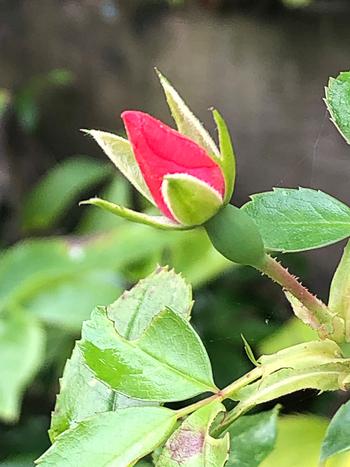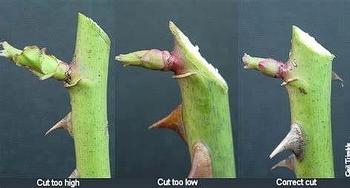Pruning & leaf stripping of roses
-
Martha Proctor
-
Someone once said: “Life is like a rose garden — watch for the thorns and keep the pest dust handy.” Marin Master Gardener rose experts advise that in addition to pest dust, another way to enhance the life of the roses in your garden is to prune them between mid-January and mid-February. Pruning will improve flower quality, stimulate growth, remove unproductive or diseased branches, give the plant an attractive shape, and maintain it in the desired size for your landscape.
 The emergence of a rosebud. Photo: Martha Proctor
The emergence of a rosebud. Photo: Martha ProctorInvest in a good pair of shears and keep them oiled, adjusted, and very sharp. If you prefer to use loppers, make sure they are the pass-through (scissor action) type. A small pruning saw works best for pruning large canes and getting into places that are too awkward or congested for shears or loppers.
Wear hard-finish clothing with long protective sleeves, e.g., denim. Always wear good, strong, durable, but flexible gloves with gauntlets to cover your forearms.
To start pruning a rose, sit or get down on your knees to look at the bud union and the canes that come from it. Identify the greenest/newest canes. Next, locate the craggy, gray older canes; cut these off flush with the bud union with your loppers. Identify canes that cross directly over the center and cut them off flush with the bud union or flush with the cane from which they are growing in the wrong direction.
Cut back to healthy wood. A good pruning cut slants at approximately a 45-degree angle. Its lowest point is opposite and slightly higher than the growth bud on the stem; the upper point is 1/4 inch above the bud or bud union where the cane originated. Roses only produce flowers on the season’s new growth, so pruning improves performance.
Canes tend to grow in the direction the top bud is pointing - cut to an outside bud on upright bushes and to an inside bud on sprawling bushes. Note the bud eye's presence at the cane's intersection and a leaflet of five. Cut about 1/4 inch away from the bud. A cut to an inner-facing eye usually produces a cane that goes straight up, which is the best way for roses to grow. Remove branches whose diameter is smaller than a pencil, as these won’t produce blooms. The remaining canes are now your bush and are ready to be pruned back.
These cuts will result in the removal of about one-third to one-half of the volume of the plant, leaving healthy canes and the center of the plant open. Use restraint and only prune roses lightly to moderately.
Fortunately, roses are very forgiving, so if you cut too low, too high, an inward-facing bud instead of an outfacing one, it’s ultimately not going to make a big difference. However, a few rules can determine whether your rose will bloom this season: 1) Don’t prune old roses (roses that bloom only once) during winter, or you will be cutting off next spring’s flowers; 2) Don’t prune newly planted roses, as they need to get established before you remove any growth; 3) Prune roses you have only grown for one season lightly, as they need all their canes to continue to thrive. Guidelines for the pruning cuts on roses. Photo: UCANR
Guidelines for the pruning cuts on roses. Photo: UCANRMany rose care experts recommend leaf stripping or removing every leaf from newly pruned bushes. Fungal spores like blackspot can overwinter on old green leaves left on the bush and reemerge the following spring. The presence of discolored pith in the interior of cane may indicate frost or disease. A dormant spray after pruning is advisable to reduce insects and diseases in the coming season.
The rose is thought by many to be the queen of flowers. Follow these guidelines in your rose garden, and you’ll enjoy a bounty of changing colors, luxurious blooms, and delectable fragrances.


